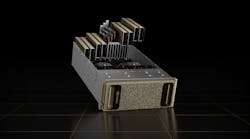Next-Gen GPUs Power the Rise of Digital Twins
Check out more coverage of GTC Fall 2022.
NVIDIA is upgrading its graphics processors to aid logistics, manufacturing, retail, and industrial giants in creating more realistic and intricate digital twins of their physical operations and products.
At GTC 2022, the Santa Clara, California-based company rolled out a new generation of hardware called OVX, specifically for creating physically accurate digital copies of (primarily industrial) systems. These digital twins are made to mimic their counterparts in the physical world as closely as possible to help reduce the costs of running factories, retail stores, or other operations and speed up new product design.
The new OVX system is backed by NVIDIA’s L40 GPU, which itself is based on the next-generation Ada Lovelace architecture named for the mathematician often regarded as the world’s first programmer. It thus gives them the ability to create increasingly vast and immersive simulations of industrial systems.
Creating digital twins requires many of the same simulation and animation capabilities the Lovelace architecture imparts to its flagship RTX 40 series of graphics processors for gaming, said NVIDIA.
The “O” in OVX stands for Omniverse, the company’s suite of software for creating three-dimensional virtual spaces and realistic recreations of the world. Using the platform, anyone from product designers to engineers can design digital copies of factories, robots, airplanes, trains, buildings, wireless networks, and more. CEO Jensen Huang has said Omniverse presents “one of the largest graphics opportunities” for the company.
Digital Doppelgangers
The concept of a digital twin has been around for years at this point. But NVIDIA is primarily trying to lure large logistics, manufacturing, and retail firms to create digital twins using Omniverse software.
With a digital twin, every facet of a factory or engine can be designed with fully simulated physics in real-time. Then, they will react to different situations as they would in the real world while remaining in the safety of a virtual world. That presents a way to interact with, and then test and validate, designs, processes, and systems before they are deployed, fixed, or upgraded in the real world.
Creating digital twins of heavy machinery on a factory floor, for instance, can help train workers how to use the equipment or even provide visibility into problems without having to disassemble them.
NVIDIA partnered with Germany’s national transportation manager Deutsche Bahn to use Omniverse to increase the efficiency, quality, and capacity of the nation’s rail network without installing any new tracks. The companies are collaborating on a new AI-powered digital twin that will usher in a railway system in which trains are automated, safely run closer together, and optimally steered through the network.
This is a massive, computationally-heavy endeavor. Photorealistic and physically accurate emulations of the whole rail system will be created, including the thousands of miles of track crisscrossing the nation through cities, smaller towns, and everywhere in between. It will meld data from many sources, ranging from the systems placed at station platforms to sensors mounted on the trains themselves.
The digital twin of the rail network will run in parallel with the actual railway network at the same time, being fed all of the same data in real time. As a result, Deutsche Bahn will be able to analyze data and run simulations to test and validate changes in the entire system, such as reactions to unforeseen situations. It will also be able to better predict and prevent incidents, allowing for more traffic on the tracks.
The concept of digital twins is expanding elsewhere, too. Home-improvement retailer Lowe’s said it has created interactive, three-dimensional models of its physical stores using Omniverse, updated in real-time with information from sensors and other systems like cash registers or credit-card terminals.
According to the company, workers wearing augmented reality headsets can access the digital twin on the ground. Using a digital twin as a reference, they can view information about the inventory in front of them, including items placed on high shelves or otherwise partially obscured.
They can also compare the holograms of the digital twin to check whether shelves are stocked correctly. By consulting the digital twin, store associates can tell if the wrong products are on the shelves or if products must be restocked.
Using Omniverse, “We’re pulling data together in ways that have never been possible,” said Seemantini Godbole, chief digital and information officer for Lowe’s.
Hardware Power-Up
NVIDIA launched its first generation OVX system in early 2022, leveraging its previous-generation Ampere GPUs. But it is now leveling up the second-generation OVX hardware with the Lovelace-based data-center L40 GPU to help create more realistic digital twins and bring them as close as possible to the real world.
The Lovelace GPU architecture, which stands apart from NVIDIA's “Hopper” GPUs that will primarily be used to speed up machine learning in data centers, uses a new generation of ray-tracing cores and tensor cores to drive the AI-powered ray-tracing technology that makes it possible to render physically accurate simulations of digital objects.
The data-center GPU is paired with 48 GB of GDDR6 memory, twice the memory of NVIDIA’s flagship GPU for personal computers (PCs), and it fits in a passively cooled package with a power envelope of 300 W. The L40 GPU also features new video encoders with support for the AV1 codec.
OVX resembles NVIDIA’s new industrial-grade ITX motherboard by using NVIDIA’s ConnectX-7 SmartNIC, bringing networking and storage performance and precision timing needed to build true-to-life digital twins. It also supports the RDMA over Converged Ethernet (RoCE) protocol, offering remote direct-memory-access (RDMA) services in applications where latency is a high priority.
Each OVX server contains eight L40 GPUs linked over PCIe Gen 4 and supplemented by three ConnectX-7 SmartNICs that supply 200-GB/s networking on each port as well as line-rate encryption. OVX includes 16 TB of NVMe flash storage.
When the need arises for even more performance and scale, the servers can be configured in “pods” of eight nodes each to “superpods” comprised of up to 32 OVX servers that are connected using NVIDIA’s Spectrum-3 switch fabric.
“Large-scale digital twins are redefining how nearly every industry plans, designs, and builds in the physical world,” said Bob Pette, head of professional visualization at NVIDIA. “OVX will provide the next generation of compute power required for the most complex digital twins of factories, buildings, and entire cities.”
Omniverse in Cloud
BMW is set to become the first to be equipped with the OVX system to simulate factories using digital twins. NVIDIA said its new L40 accelerator card is currently in production, while its new OVX platform will be available from the likes of Lenovo, Supermicro, and other OEMs starting in early 2023.
Jurgen Wittmann, head of innovation at BMW, said the use of the Omniverse-ready systems will give it the performance and scale needed “to develop large-scale photorealistic models of our factories and create true-to-reality simulations that will transform our manufacturing, design, and production processes.”
NVIDIA is also positioning the Lovelace architecture as the engine of its first software-as-a-service offering, which will give customers access to Omniverse hardware and software in the cloud on demand.
According to NVIDIA, Omniverse Cloud gives everyone the ability to design and collaborate on digital twins and other 3D objects and spaces with on-demand computing power. The service includes a wide range of software tools, including Isaac Sim, which makes the testing and training of virtual robots more widely accessible.
Rimac is using the Omniverse-in-the-cloud service to help streamline its design process for electric vehicles (EVs).
"Electric motors are efficient and can adjust in an instant," said CEO Mate Rimac in a statement. "Omniverse Cloud will provide similar efficiency and flexibility, enabling our engineering teams to focus on the design of the car itself and spend less time on the intricacies of complex 3D design pipelines."
Check out more coverage of GTC Fall 2022.



